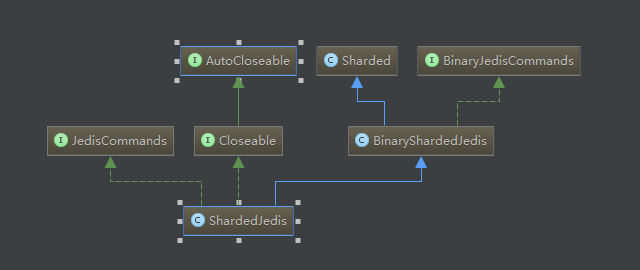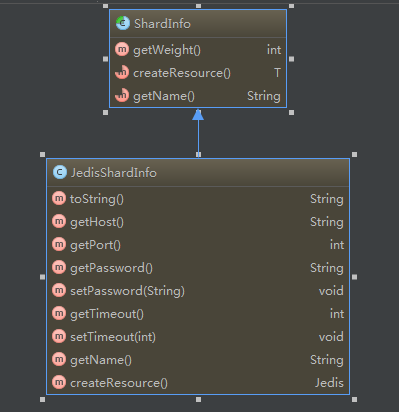Jedis之ShardedJedis一致性哈希分析
ShardedJedis通过一致性哈希实现的的分布式缓存。主要思路:
redis服务器节点划分:将每台服务器节点采用hash算法划分为160个虚拟节点(可以配置划分权重)
将划分虚拟节点采用TreeMap存储
对每个redis服务器的物理连接采用LinkedHashMap存储
对Key or KeyTag 采用同样的hash算法,然后从TreeMap获取大于等于键hash值得节点,取最邻近节点存储;当key的hash值大于虚拟节点hash值得最大值时,存入第一个虚拟节点
sharded采用的hash算法:MD5 和 MurmurHash两种;默认采用64位的MurmurHash算法;
源码:
|
1
2
3
4
5
6
7
8
9
|
public
class
Sharded<R, S
extends
ShardInfo<R>> {
public
static
final
int
DEFAULT_WEIGHT =
1
;
private
TreeMap<Long, S> nodes;
private
final
Hashing algo;
private
final
Map<ShardInfo<R>, R> resources =
new
LinkedHashMap<ShardInfo<R>, R>();
........................
........................
}
|
这个类维护了一致性哈希后的物理机器和虚拟节点的映射关系,看一张图你会秒懂,
TreeMap<Long, S> nodes,存储的是虚拟节点和key的映射关系。有了虚拟节点,还要找到真正的存储位置。
Map<ShardInfo<R>, R> resources维护了虚拟节点和真正的存储位置的映射关系。
也是说,hash(key) -> virtual node -> real node;
jedis划分虚拟节点的逻辑代码,在Sharded类中,方法是initialize。这是在实例化对象池ShardedJedisPool过程中执行的划分虚拟节点。
|
1
2
3
4
5
6
7
8
9
10
11
12
13
14
15
16
17
|
private
void
initialize(List<S> shards) {
nodes =
new
TreeMap<Long, S>();
for
(
int
i =
0
; i != shards.size(); ++i) {
final
S shardInfo = shards.get(i);
if
(shardInfo.getName() ==
null
) {
for
(
int
n =
0
; n <
160
* shardInfo.getWeight(); n++) {
nodes.put(
this
.algo.hash(
"SHARD-"
+ i +
"-NODE-"
+ n), shardInfo);
}
}
else
{
for
(
int
n =
0
; n <
160
* shardInfo.getWeight(); n++) {
nodes.put(
this
.algo.hash(shardInfo.getName() +
"*"
+ shardInfo.getWeight() + n), shardInfo);
}
}
resources.put(shardInfo, shardInfo.createResource());
}
}
|
以上代码就是划分虚拟节点的逻辑。
那么ShardedJedis客户端是如何执行set key value呢?
通过这里可以看出还是通过Jedis客户端执行的set key value。
|
1
2
3
4
|
public
String set(String key, String value) {
Jedis j = getShard(key);
return
j.set(key, value);
}
|
看一下代码中大体的逻辑,首先通过key得到ShardInfo,然后通过ShardInfo得到泛型Jedis客户端。
Sharded.java
|
1
2
3
|
public
R getShard(
byte
[] key) {
return
resources.get(getShardInfo(key));
}
|
|
1
2
3
4
5
6
7
|
public
S getShardInfo(
byte
[] key) {
SortedMap<Long, S> tail = nodes.tailMap(algo.hash(key));
if
(tail.isEmpty()) {
return
nodes.get(nodes.firstKey());
}
return
tail.get(tail.firstKey());
}
|
来看一下ShardedJedis的继承关系吧,
还有ShardInfo和JedisShardInfo继承关系,
参考:http://yychao.iteye.com/blog/1751583
=================END=================


